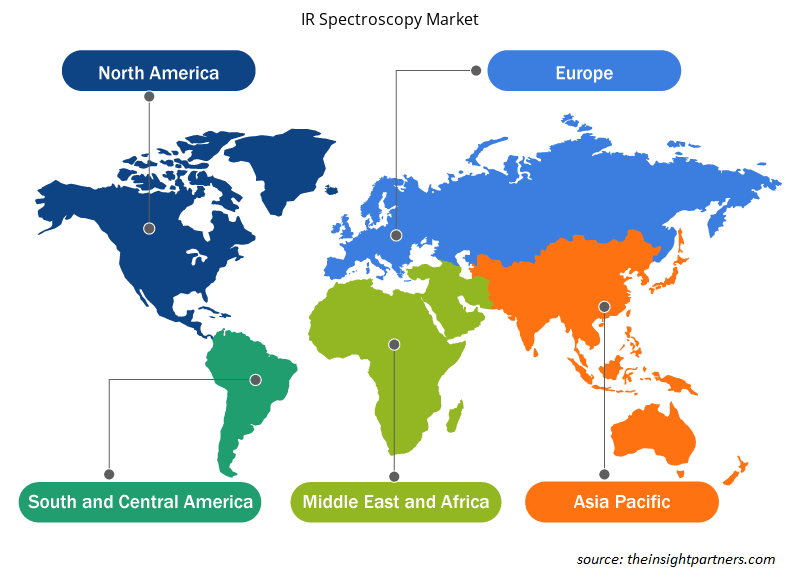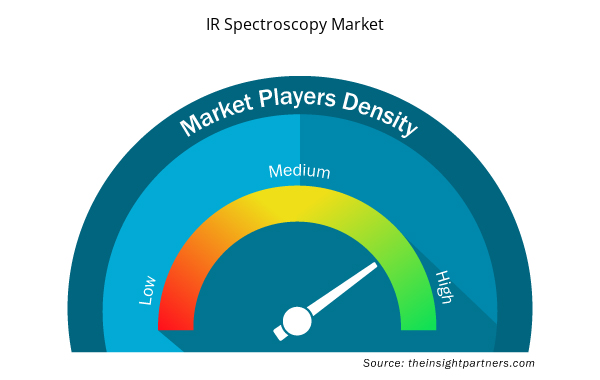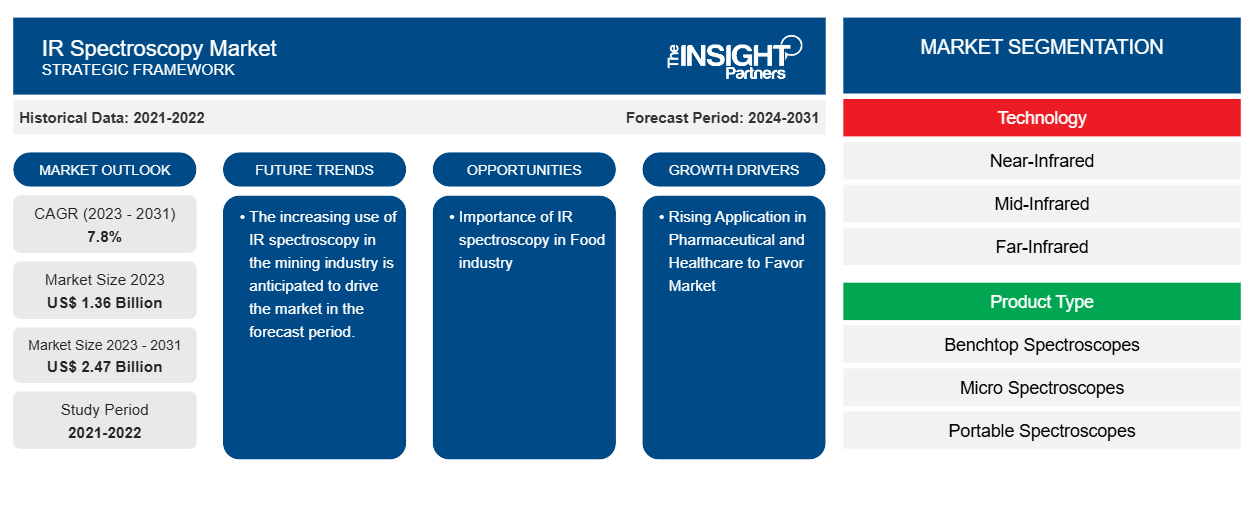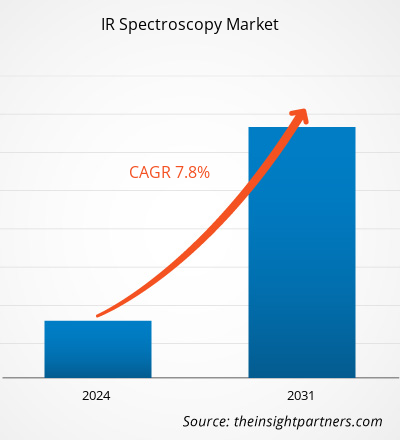Si prevede che la dimensione del mercato della spettroscopia IR raggiungerà i 2,47 miliardi di dollari entro il 2031, passando dagli 1,36 miliardi di dollari del 2023. Si prevede che il mercato registrerà un CAGR del 7,8% nel periodo 2023-2031. Le crescenti applicazioni nei settori farmaceutico e sanitario e la crescita emergente nel settore alimentare rimarranno probabilmente tendenze e driver chiave nel mercato.CAGR of 7.8% during 2023–2031. Increasing applications in the pharmaceutical and healthcare industries and emerging growth in the food industry are likely to remain key trends and drivers in the market.
Analisi di mercato della spettroscopia IR
Si prevede che la domanda per il mercato della spettroscopia IR crescerà con il crescente numero di strutture mediche e centri di ricerca clinica in tutto il mondo. Inoltre, la crescente applicazione nel settore farmaceutico e sanitario e la crescente attenzione della spettroscopia IR nelle economie emergenti. Inoltre, si prevede che il mercato crescerà con l'ascesa del settore alimentare.centres across the world. Also, the rising application in the pharmaceutical and healthcare industry and growing focus of IR spectroscopy in emerging economies. Moreover, the market is anticipated to grow with the rise in the food industry.
Panoramica del mercato della spettroscopia IR
La spettroscopia infrarossa (spettroscopia IR) è la spettroscopia che si occupa della regione infrarossa dello spettro elettromagnetico, ovvero la luce con una lunghezza d'onda maggiore e una frequenza inferiore rispetto alla luce visibile. Copre una gamma di tecniche, per lo più basate sulla spettroscopia di assorbimento. Come tutte le tecniche spettroscopiche, può essere utilizzata per identificare e studiare le sostanze chimiche.
Personalizza questo report in base alle tue esigenze
Riceverai la personalizzazione gratuita di qualsiasi report, comprese parti di questo report, o analisi a livello nazionale, pacchetto dati Excel, oltre a usufruire di grandi offerte e sconti per start-up e università
- Scopri le principali tendenze di mercato in questo rapporto.Questo campione GRATUITO includerà analisi di dati che spaziano dalle tendenze di mercato alle stime e alle previsioni.
Driver e opportunità del mercato della spettroscopia IR
Crescente applicazione nel settore farmaceutico e sanitario per favorire il mercato
Le persone anziane del mondo hanno attualmente vari deficit psichiatrici e neurologici . Inoltre, le funzioni cerebrali di questi pazienti sono profondamente compromesse, limitando così la loro indipendenza nella vita quotidiana. In questi casi, la spettroscopia IR è molto essenziale. Inoltre, la spettroscopia nel vicino infrarosso è utilizzata nella sintesi e purificazione di API (principi attivi farmaceutici) e fermentazioni biofarmaceutiche. La tecnologia è ideale perché è stata progettata per analizzare miscele complesse.
Importanza della spettroscopia IR nell'industria alimentare.
Negli ultimi anni, il metodo della spettroscopia infrarossa per l'analisi degli alimenti si è sviluppato in modo significativo. La spettroscopia infrarossa può essere utilizzata per condurre un'analisi della qualità su diverse famiglie di gruppi alimentari come carne, frutta, pesce, verdura, latticini, uova e cereali. Poiché la tecnica della spettroscopia infrarossa si è sviluppata e si è evoluta nella sua applicazione nell'analisi degli alimenti, è infine diventata uno strumento affidabile e potente. Il metodo ha vari vantaggi che lo rendono lo strumento analitico appropriato per molti gruppi alimentari e aziende alimentari.
Analisi della segmentazione del rapporto di mercato sulla spettroscopia IR
I segmenti chiave che hanno contribuito alla derivazione dell'analisi di mercato della spettroscopia IR sono la tecnologia, il tipo di prodotto e l'utente finale.
- In base alla tecnologia, il mercato della spettroscopia IR è suddiviso in vicino infrarosso, medio infrarosso e lontano infrarosso. Si prevede che il segmento vicino infrarosso detenga una quota di mercato significativa nel periodo di previsione.
- In base al tipo di prodotto, il mercato della spettroscopia IR è suddiviso in spettroscopi da banco , microspettroscopi, spettroscopi portatili e spettroscopi con trattino. Si prevede che il segmento degli spettroscopi da banco detenga una quota di mercato significativa nel periodo di previsione.
- In base all'utente finale, il mercato è segmentato in sanità, prodotti chimici, petrolio e gas, alimenti e bevande e altri utenti finali. Si prevede che il segmento sanitario detenga una quota di mercato significativa nel periodo di previsione.
Analisi della quota di mercato della spettroscopia IR per area geografica
L'ambito geografico del rapporto di mercato sulla spettroscopia IR è suddiviso principalmente in cinque regioni: Nord America, Asia Pacifico, Europa, Medio Oriente e Africa, Sud e Centro America.
Il Nord America ha dominato il mercato. Il mercato della spettroscopia IR sta crescendo in Nord America a causa della robusta crescita della domanda di spettroscopia IR in vari settori come sanità, prodotti farmaceutici, prodotti chimici e alimenti e bevande. Inoltre, la forte enfasi sulla ricerca e sviluppo sta rendendo la regione tecnologicamente avanzata. Inoltre, il Nord America comprende un gran numero di produttori di spettroscopia IR. Pertanto, a causa dei parametri di cui sopra, il mercato della spettroscopia IR sta crescendo in Nord America.
Approfondimenti regionali sul mercato della spettroscopia IR
Le tendenze regionali e i fattori che influenzano il mercato della spettroscopia IR durante il periodo di previsione sono stati ampiamente spiegati dagli analisti di Insight Partners. Questa sezione discute anche i segmenti e la geografia del mercato della spettroscopia IR in Nord America, Europa, Asia Pacifico, Medio Oriente e Africa e America meridionale e centrale.

- Ottieni i dati specifici regionali per il mercato della spettroscopia IR
Ambito del rapporto di mercato sulla spettroscopia IR
| Attributo del report | Dettagli |
|---|---|
| Dimensioni del mercato nel 2023 | 1,36 miliardi di dollari USA |
| Dimensioni del mercato entro il 2031 | 2,47 miliardi di dollari USA |
| CAGR globale (2023-2031) | 7,8% |
| Dati storici | 2021-2022 |
| Periodo di previsione | 2024-2031 |
| Segmenti coperti | Per tecnologia
|
| Regioni e Paesi coperti | America del Nord
|
| Leader di mercato e profili aziendali chiave |
|
Densità degli attori del mercato: comprendere il suo impatto sulle dinamiche aziendali
Il mercato della spettroscopia IR sta crescendo rapidamente, spinto dalla crescente domanda degli utenti finali dovuta a fattori quali l'evoluzione delle preferenze dei consumatori, i progressi tecnologici e una maggiore consapevolezza dei vantaggi del prodotto. Con l'aumento della domanda, le aziende stanno ampliando le loro offerte, innovando per soddisfare le esigenze dei consumatori e capitalizzando sulle tendenze emergenti, il che alimenta ulteriormente la crescita del mercato.
La densità degli operatori di mercato si riferisce alla distribuzione di aziende o società che operano in un particolare mercato o settore. Indica quanti concorrenti (operatori di mercato) sono presenti in un dato spazio di mercato in relazione alle sue dimensioni o al valore di mercato totale.
Le principali aziende che operano nel mercato della spettroscopia IR sono:
- Tecnologie Agilent
- Inc.
- Società Bruker
- Hitachi
- Società anonima
- Azienda HORIBA LTD
Disclaimer : le aziende elencate sopra non sono classificate secondo un ordine particolare.

- Ottieni una panoramica dei principali attori del mercato della spettroscopia IR
Notizie di mercato e sviluppi recenti sulla spettroscopia IR
Il mercato della spettroscopia IR viene valutato raccogliendo dati qualitativi e quantitativi post-ricerca primaria e secondaria, che includono importanti pubblicazioni aziendali, dati di associazioni e database. Di seguito sono elencati alcuni degli sviluppi nel mercato della spettroscopia IR:
- Wiley, uno dei più grandi editori al mondo e leader globale nella ricerca e nell'apprendimento, ha annunciato il rilascio del nuovo Wiley Database of Predicted IR Spectra. Il database combina oltre 60 anni di esperienza nella spettroscopia infrarossa (IR) e nella cura dei dati spettrali con le più attuali tecniche di apprendimento automatico per espandere significativamente il numero di dati spettrali IR disponibili per l'analisi spettrale. (Fonte: Wiley, sito Web aziendale, novembre 2023)
- Edinburgh Instruments ha annunciato il lancio del suo nuovo spettrometro FTIR da banco, l'IR5, progettato e prodotto presso la sede centrale globale in Scozia. L'IR5 è il primo spettrometro a infrarossi a trasformata di Fourier (FTIR) del marchio Edinburgh Instruments, rinomato per la sua competenza nella strumentazione per spettroscopie di assorbimento Raman, fluorescenza e UV-Vis. (Fonte: Edinburgh Instruments, sito Web aziendale, marzo 2023)
Copertura e risultati del rapporto di mercato sulla spettroscopia IR
Il rapporto "Dimensioni e previsioni del mercato della spettroscopia IR (2021-2031)" fornisce un'analisi dettagliata del mercato che copre le seguenti aree:
- Dimensioni e previsioni del mercato della spettroscopia IR a livello globale, regionale e nazionale per tutti i principali segmenti di mercato trattati nell'ambito dell'indagine.
- Tendenze del mercato della spettroscopia IR e dinamiche di mercato, quali fattori trainanti, limitazioni e opportunità chiave.
- Analisi dettagliata delle cinque forze PEST/Porter e SWOT.
- Analisi di mercato della spettroscopia IR che copre le principali tendenze del mercato, il quadro globale e regionale, i principali attori, le normative e i recenti sviluppi del mercato.
- Analisi del panorama industriale e della concorrenza che comprende la concentrazione del mercato, l'analisi delle mappe di calore, i principali attori e gli sviluppi recenti per il mercato della spettroscopia IR.
- Profili aziendali dettagliati.
- Analisi storica (2 anni), anno base, previsione (7 anni) con CAGR
- Analisi PEST e SWOT
- Valore/volume delle dimensioni del mercato - Globale, regionale, nazionale
- Industria e panorama competitivo
- Set di dati Excel


- Excimer & Femtosecond Ophthalmic Lasers Market
- Small Satellite Market
- Data Center Cooling Market
- Foot Orthotic Insoles Market
- 3D Audio Market
- Environmental Consulting Service Market
- Truck Refrigeration Market
- Organoids Market
- Lyophilization Services for Biopharmaceuticals Market
- Visualization and 3D Rendering Software Market

Report Coverage
Revenue forecast, Company Analysis, Industry landscape, Growth factors, and Trends

Segment Covered
This text is related
to segments covered.

Regional Scope
North America, Europe, Asia Pacific, Middle East & Africa, South & Central America

Country Scope
This text is related
to country scope.
Domande frequenti
North America is anticipated to dominate the IR spectroscopy market in 2023.
Growing infrastructure projects promoting applications of bucket elevators and growing demand for bucket elevators in the fertilizer industry are some of the factors driving the IR spectroscopy market.
The increasing use of IR spectroscopy in the mining industry is anticipated to drive the market in the forecast period.
The key players holding majority shares in the global IR spectroscopy market are Agilent Technologies, Inc., Bruker Corporation, Hitachi, Ltd., HORIBA LTD, JASCO International Co., PerkinElmer Inc., Shimadzu Corporation Ltd, Thermo Fisher Scientific Inc., Lumex Instruments, Carl Zeiss AG
The global IR spectroscopy market is expected to reach US$ 2. billion by 2031.
The expected CAGR of the IR spectroscopy market is 7.8%.
Trends and growth analysis reports related to Electronics and Semiconductor : READ MORE..
The Insight Partners performs research in 4 major stages: Data Collection & Secondary Research, Primary Research, Data Analysis and Data Triangulation & Final Review.
- Data Collection and Secondary Research:
As a market research and consulting firm operating from a decade, we have published and advised several client across the globe. First step for any study will start with an assessment of currently available data and insights from existing reports. Further, historical and current market information is collected from Investor Presentations, Annual Reports, SEC Filings, etc., and other information related to company’s performance and market positioning are gathered from Paid Databases (Factiva, Hoovers, and Reuters) and various other publications available in public domain.
Several associations trade associates, technical forums, institutes, societies and organization are accessed to gain technical as well as market related insights through their publications such as research papers, blogs and press releases related to the studies are referred to get cues about the market. Further, white papers, journals, magazines, and other news articles published in last 3 years are scrutinized and analyzed to understand the current market trends.
- Primary Research:
The primarily interview analysis comprise of data obtained from industry participants interview and answers to survey questions gathered by in-house primary team.
For primary research, interviews are conducted with industry experts/CEOs/Marketing Managers/VPs/Subject Matter Experts from both demand and supply side to get a 360-degree view of the market. The primary team conducts several interviews based on the complexity of the markets to understand the various market trends and dynamics which makes research more credible and precise.
A typical research interview fulfils the following functions:
- Provides first-hand information on the market size, market trends, growth trends, competitive landscape, and outlook
- Validates and strengthens in-house secondary research findings
- Develops the analysis team’s expertise and market understanding
Primary research involves email interactions and telephone interviews for each market, category, segment, and sub-segment across geographies. The participants who typically take part in such a process include, but are not limited to:
- Industry participants: VPs, business development managers, market intelligence managers and national sales managers
- Outside experts: Valuation experts, research analysts and key opinion leaders specializing in the electronics and semiconductor industry.
Below is the breakup of our primary respondents by company, designation, and region:

Once we receive the confirmation from primary research sources or primary respondents, we finalize the base year market estimation and forecast the data as per the macroeconomic and microeconomic factors assessed during data collection.
- Data Analysis:
Once data is validated through both secondary as well as primary respondents, we finalize the market estimations by hypothesis formulation and factor analysis at regional and country level.
- Macro-Economic Factor Analysis:
We analyse macroeconomic indicators such the gross domestic product (GDP), increase in the demand for goods and services across industries, technological advancement, regional economic growth, governmental policies, the influence of COVID-19, PEST analysis, and other aspects. This analysis aids in setting benchmarks for various nations/regions and approximating market splits. Additionally, the general trend of the aforementioned components aid in determining the market's development possibilities.
- Country Level Data:
Various factors that are especially aligned to the country are taken into account to determine the market size for a certain area and country, including the presence of vendors, such as headquarters and offices, the country's GDP, demand patterns, and industry growth. To comprehend the market dynamics for the nation, a number of growth variables, inhibitors, application areas, and current market trends are researched. The aforementioned elements aid in determining the country's overall market's growth potential.
- Company Profile:
The “Table of Contents” is formulated by listing and analyzing more than 25 - 30 companies operating in the market ecosystem across geographies. However, we profile only 10 companies as a standard practice in our syndicate reports. These 10 companies comprise leading, emerging, and regional players. Nonetheless, our analysis is not restricted to the 10 listed companies, we also analyze other companies present in the market to develop a holistic view and understand the prevailing trends. The “Company Profiles” section in the report covers key facts, business description, products & services, financial information, SWOT analysis, and key developments. The financial information presented is extracted from the annual reports and official documents of the publicly listed companies. Upon collecting the information for the sections of respective companies, we verify them via various primary sources and then compile the data in respective company profiles. The company level information helps us in deriving the base number as well as in forecasting the market size.
- Developing Base Number:
Aggregation of sales statistics (2020-2022) and macro-economic factor, and other secondary and primary research insights are utilized to arrive at base number and related market shares for 2022. The data gaps are identified in this step and relevant market data is analyzed, collected from paid primary interviews or databases. On finalizing the base year market size, forecasts are developed on the basis of macro-economic, industry and market growth factors and company level analysis.
- Data Triangulation and Final Review:
The market findings and base year market size calculations are validated from supply as well as demand side. Demand side validations are based on macro-economic factor analysis and benchmarks for respective regions and countries. In case of supply side validations, revenues of major companies are estimated (in case not available) based on industry benchmark, approximate number of employees, product portfolio, and primary interviews revenues are gathered. Further revenue from target product/service segment is assessed to avoid overshooting of market statistics. In case of heavy deviations between supply and demand side values, all thes steps are repeated to achieve synchronization.
We follow an iterative model, wherein we share our research findings with Subject Matter Experts (SME’s) and Key Opinion Leaders (KOLs) until consensus view of the market is not formulated – this model negates any drastic deviation in the opinions of experts. Only validated and universally acceptable research findings are quoted in our reports.
We have important check points that we use to validate our research findings – which we call – data triangulation, where we validate the information, we generate from secondary sources with primary interviews and then we re-validate with our internal data bases and Subject matter experts. This comprehensive model enables us to deliver high quality, reliable data in shortest possible time.


 Ottieni un campione gratuito per questo repot
Ottieni un campione gratuito per questo repot